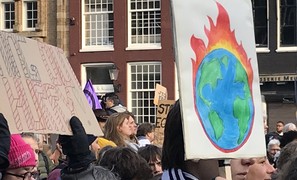The future of clean air: Are agreements effective?

By Elly Gabel, Associate Editor of Revolutionized
Photo: Dick Duckhorn (www.flickr.com)
The European Union and the U.K. have established optimistic plans and goals for cleaning the air. The effectiveness of these agreements demands an objective review. Is there enough accountability to hold momentum and force promises to lead to evidence-based action?
Zero Pollution Action Plan
EU partners revised the Zero Pollution Action Plan in February 2024. The objective strives for no pollutants in the air, water and soil by 2050. Parliament members agreed this goal will allow citizens to breathe better and live healthier lives. The plan increases the number of air samples required across Europe, focusing on fine particulate matter and nitrogen dioxide.
Unfortunately, the current standards do not meet the World Health Organization’s recommendations. For example, the air quality guidelines urge particulate matter to not exceed five μg/m3, yet the Action Plan approves 10 µg/m3. Numbers for nitrogen dioxide show a similar problem.
The EU Commission should reevaluate the plan before 2030, with many hoping it will become more robust. Its current form is progress, but it could challenge itself to do more for the air and human health.
U.N. emissions targets
Governments are misconstruing air pollution data reports and it is a global problem. The European Commission’s Joint Research Centre in Italy published work stating how complex it is to measure all air pollutants.
Corporations may falsely report how many fossil fuels they burn or neglect to consider fugitive emissions. The UN must update its formulaic structures and accountability measures to obtain more transparent numbers based on genuine operational habits.
Multilateral Environmental Agreements (MEAs)
MEAs foster international efforts to help the planet. Recent discussions from the U.N.’s Environmental Assembly evaluated their stance on air pollution, which causes seven million deaths annually all over the world. The Air Convention has been around for over 45 years and discussions outlined its success while asserting the need for continued science-based policy. The Executive Secretary mentioned it was why it was successful in influencing policy.
They acknowledged its interregional shortcomings. So, the Convention created the International Task Force for International Cooperation on Air Pollution. If this is as lucrative as the project that catalyzed it, more binding agreements about air health could arise worldwide.
Jet-zero flight
The U.K. promised to obtain “jet-zero” flights by 2050, yet aircraft continue to guzzle fuel and energy. Air pollution may worsen as people travel more frequently. Are the U.K. Department for Transport’s ideas leading to sustainable aviation advancements? The plan has oversights. This poses problems for clean air’s future, primarily as it does clarify a road map for eliminating pollutants from the sector.
Environmental analysts cite concerns with the plan’s inability to consider scaling, suggesting the timeline relies on infant technologies to usher in a new age of flight. The plan fails to detail how it intends to research, develop and integrate sustainable flight tech simultaneously. For green airline technologies to meld with modern flight behaviors, demand must decline. Asking airlines to rally for reduced business is a losing battle. However, there are ways to dissuade excess luxury travel while expanding ethically.
Can Europe keep up?
Plans, policies, goals and objectives are all critical for establishing cooperative mindsets in tackling the climate crisis. It is vital for fields like air pollution, which are hard to visualize. Everyone must mend the gaps in existing agreements to promote a new standard for international air quality. Humanity is on the right path, but it is always better to strive for even cleaner air.






